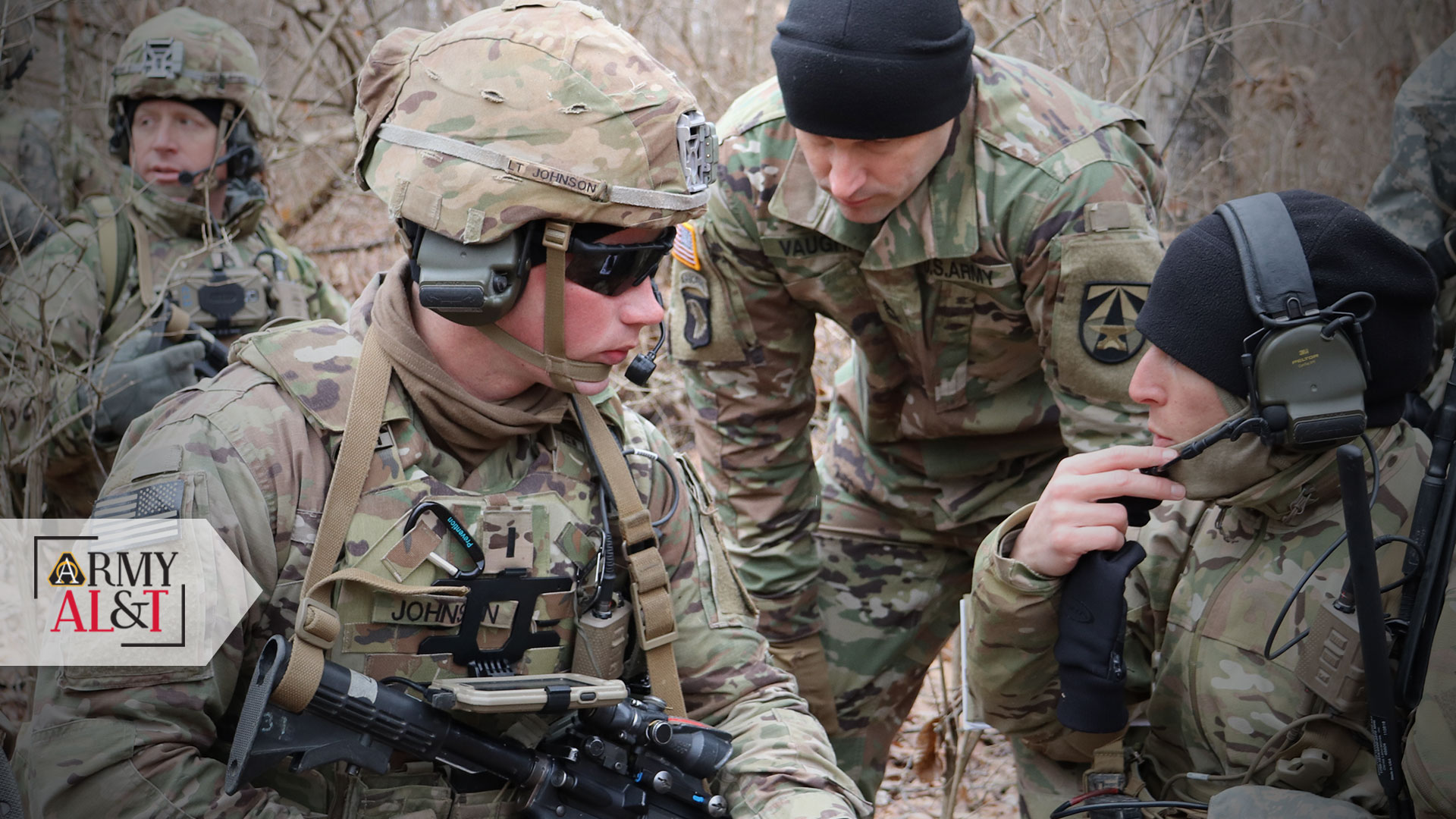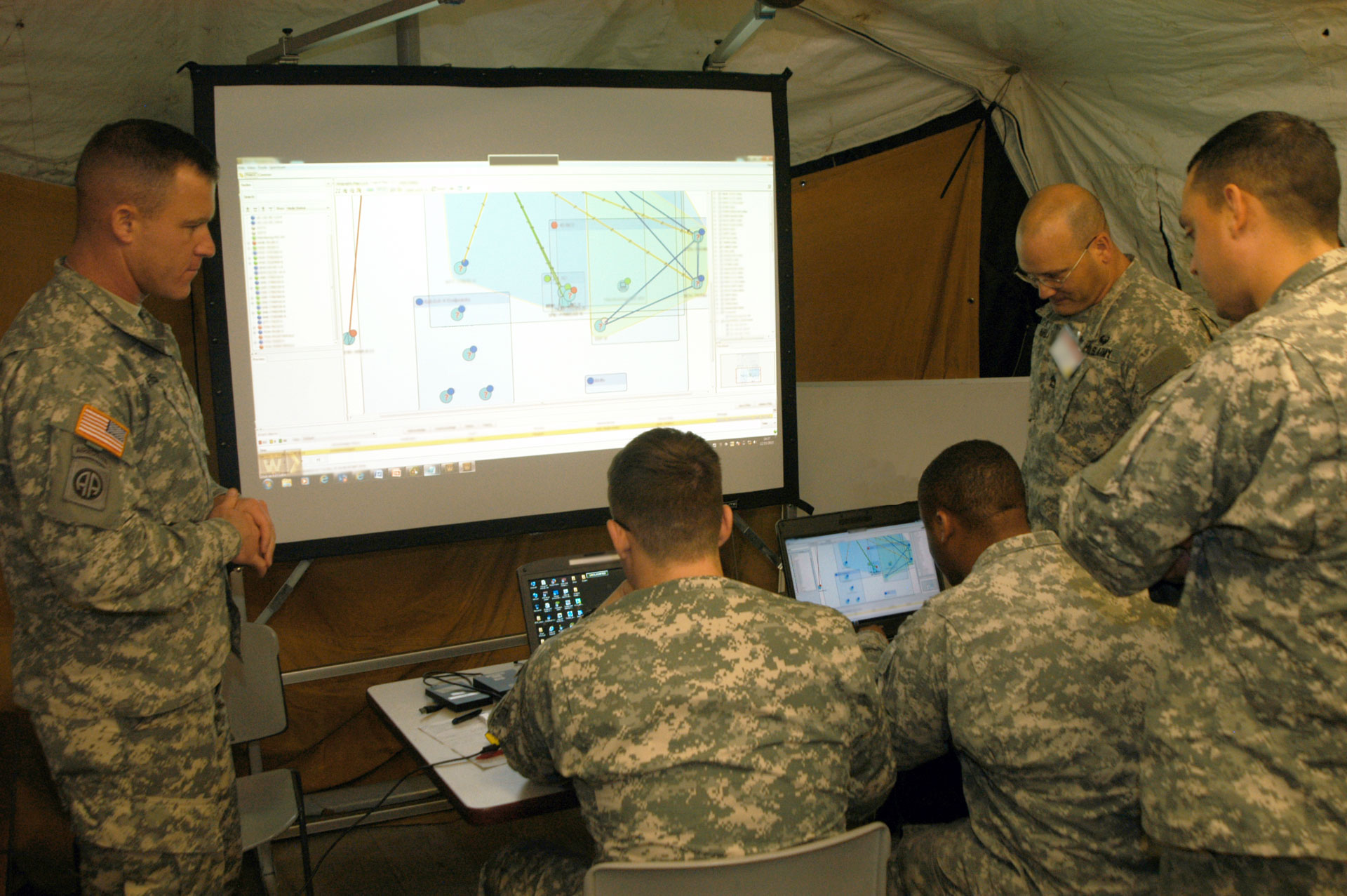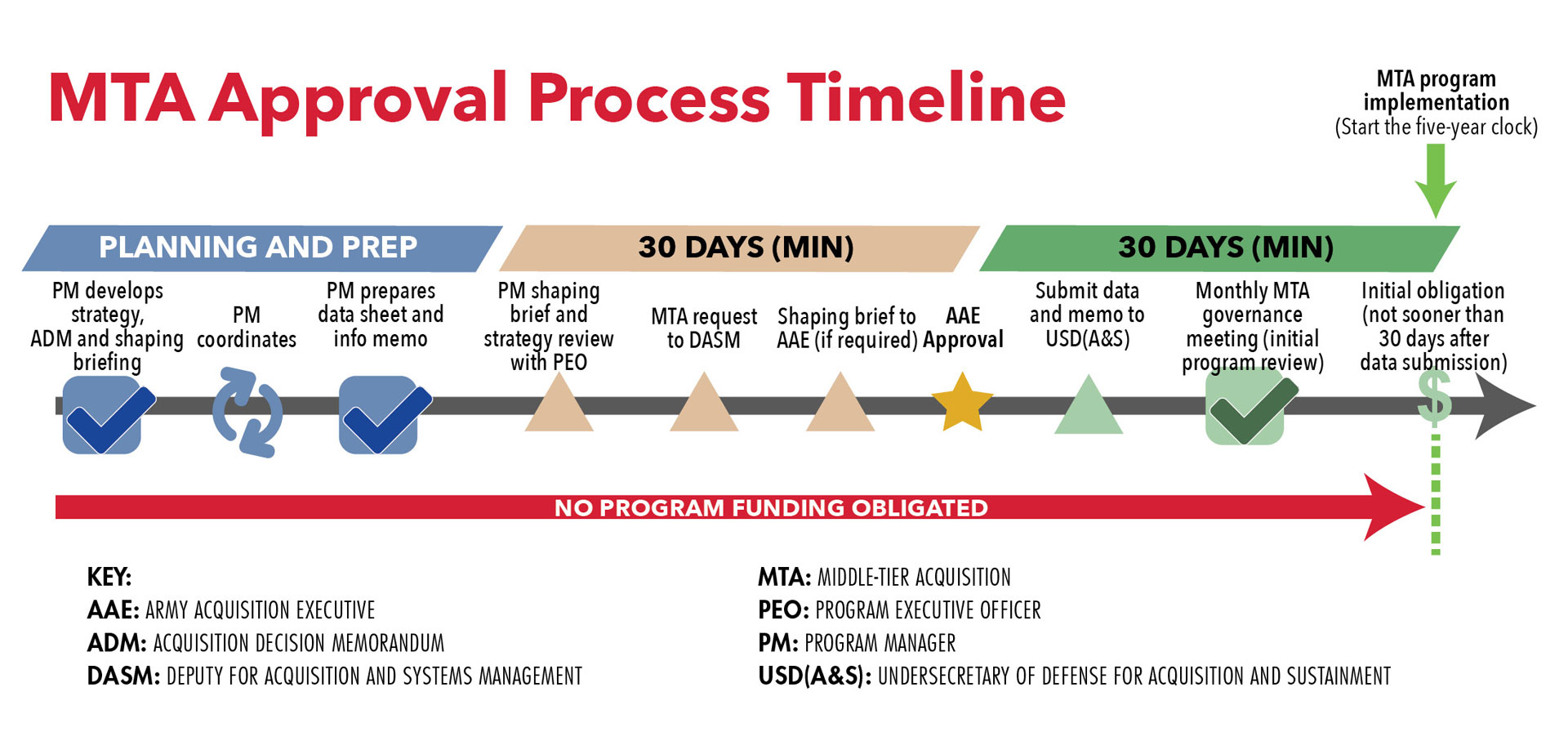
Middle-tier acquisition authority features flexible prototype and fielding options.
by Douglas Burbey, Mindy Gabbert and Kathryn Bailey
The Army is employing one more option for programs of record to accelerate the way they usher Soldier technologies along the path from innovative concepts to fielded capability.
Middle-tier acquisition authority, granted by Congress in Section 804 of the National Defense Authorization Act for Fiscal Year 2016, allows the Army acquisition executive (AAE) to determine if a program of record can place its capability on a more flexible acquisition path to meet emerging military needs.
In doing so, a program of record’s product or program manager should be prepared to break new ground every day when navigating the process of middle-tier acquisition. The time spent with every staff element along the acquisition path is crucial.
Situated between the acquisition pathways of “urgent” and “tailorable traditional DOD 5000.02,” middle-tier acquisition is for programs that house mature prototypes from government and industry that should not require much additional development to begin production.
In May, the AAE empowered the Program Executive Office for Command, Control and Communications – Tactical (PEO C3T) to use the process for two of its top efforts—the Integrated Tactical Network and Unified Network Operations—both of which support the Network Cross-Functional Team and Army network modernization initiatives.
As part of the middle-tier acquisition approval process, the AAE determines if a capability warrants one of three acquisition courses of action: rapid prototyping, rapid fielding, or both. With rapid prototyping, programs must field a prototype that can be demonstrated in an operational environment, and also ensure operational capability within five years of an approved requirement. The rapid fielding designator, which inserts proven technologies into the field, requires production to begin within six months, and fielding to be completed within five years of an approved requirement.
The AAE designated the Integrated Tactical Network and Unified Network Operations as middle-tier acquisition prototype efforts, and named PEO C3T the decision authority and office of primary responsibility.
Middle-tier acquisition begins with a blank slate and allows the program, as decision authority, to build an acquisition process appropriate to the capability’s maturity and mission needs. This enables programs to field capabilities in two to five years or sooner, versus the seven to 12 years often associated with the traditional acquisition process. With middle-tier acquisition, programs can forgo the multiple checklists, signatures and annexes. For PEO C3T, the familiar 200-page acquisition strategy is now a 17-page acquisition plan. Even though the middle-tier acquisition process is less structured, and allows programs to “tailor in” versus “tailor out” the artifacts or requirements often itemized on a checklist, it does not negate the need for structure.
“MTA [middle-tier acquisition] doesn’t replace good program management,” said Joe Welch, deputy program executive officer for C3T. “We still focus on cost, schedule and performance program fundamentals to ensure that we are doing right by the taxpayers and delivering the products Soldiers need as expeditiously as possible.”
With that in mind, clearly describing the acquisition process you intend to use, and the resources you require, is crucial to achieving stakeholder and leadership buy-in.
Depending on circumstances, PEO C3T may select other options in its acquisition toolkit, such as the more traditional Acquisition Category (ACAT) II or ACAT III, which can be highly tailored and effective when requirements are already well-established. Additionally, modifications and engineering change proposals to existing programs can be suitable alternatives to quickly add capabilities instead of starting new programs. No matter the acquisition “wrapper” that is used, programs can apply additional flexibilities, such as other transaction authorities, which are contract vehicles especially well-suited for research and development, that can be used alone or with middle-tier acquisitions. Each of these flexibilities provides options to best structure acquisition efforts and put technologies into the hands of Soldiers.

NEW TACTICS
Soldiers from the 101st Airborne Division and the 10th Mountain Division test the Unified Network Operations user interface, which provides a common operating picture to signal brigades in theater, for strategic to tactical-level network management and increased situational awareness. (U.S. Army photo)
RIGHT PROCESS FOR THE RIGHT TECHNOLOGY
Middle-tier acquisition provides programs the latitude to revise or revalidate requirements during both the prototyping and fielding phases of the program. This paradigm works well with the Integrated Tactical Network and Unified Network Operations development efforts, since both follow the developmental operations (DevOps) process of incorporating real-time operational feedback from Soldiers to generate requirements.
Developmental operations feed into the Army Network’s capability-set plan, starting in fiscal year 2021, which will field new integrated network capability sets every two years to incrementally insert military and leading-edge commercial technologies to meet the Army’s warfighting needs. The capability set process targets mature capabilities used in special operations forces, the Network Cross-Functional Team, other government agencies or industry for further prototyping and to validate technological concepts in large brigade combat team-size employments.
“MTA drops the imperative of establishing formal requirements approved by the Joint Capabilities Integration and Development System and DOD Directive 5000.01 before program initiation,” Welch said. “This frees us up to get started on prototyping efforts with just a basic set of objectives, which can be iteratively refined throughout the effort to ensure they meet the needs of Soldiers.”
INTEGRATED TACTICAL NETWORK
The Integrated Tactical Network effort is injecting new commercial components and network transport capabilities to lower echelons within the Army’s tactical network environment to provide smaller, lighter, faster and more flexible communications systems with multiple connectivity options. Because it features separate components versus one piece of equipment, each component may have a slightly different acquisition path, which is easily managed with the middle-tier acquisition process.
Soldier touch-point tests for the Integrated Tactical Network will lead up to fielding four infantry brigade combat teams in fiscal year 2021, with subsequent experimentation informing Capability Sets 23 and 25. At program review points, the program will use preliminary and critical design review processes to inform capability-set network decisions.
Not all technologies transition from rapid prototyping to rapid fielding; the PEO has the option to transition any technology to its own program of record, and it will make that determination with the Integrated Tactical Network if and when warranted. Integrated Tactical Network components are expected to transition from rapid prototyping to rapid fielding throughout the middle-tier acquisition strategy’s five-year timeline.
One other scenario exists, and that is when a prototype proves unsuccessful. Failure requires a change of mindset that must be understood by all of the team members. “If it’s not working, then that’s OK; don’t burn resources on prototypes that are not producing positive results,” said Kelly Tisch, product manager for SATCOM/Tactical Cyber and chief of the Network Operations Business Management Division for PEO C3T’s Project Manager (PM) for Tactical Network. “Our DevOps process, with positive and negative feedback, allows us to change direction.”
UNIFIED NETWORK OPERATIONS
Unified Network Operations will provide common network planning, configuration, management and monitoring via open framework and standards.
Like the Integrated Tactical Network, the Unified Network Operations effort is benefiting from the middle-tier acquisition designation. As a software-based capability that leverages commercial technology to integrate across echelons, Unified Network Operations would have required input from multiple stakeholders just to form a set of requirements.
“Under DOD 5000, we would have had to develop a unified requirements document that addressed the tactical and enterprise network,” Welch said. “The process to collaborate with all of the stakeholders would have been much more time-consuming, and costly. With MTA, we can move forward as a rapid prototype, and we did this with just receiving a memo out of the Cyber Center of Excellence.”
In addition, by not needing formal requirements, the Army was able to quickly perform market research with industry to leverage its approach for developing an overarching network capability such as Unified Network Operations. Through requests for proposals and technical exchange meetings—initiated by the Network Cross-Functional Team―the team was able to determine options for integrating existing capabilities with minimum development efforts.

MID-TIER MILESTONES
The middle-tier acquisition process, authorized by the National Defense Authorization Act for Fiscal Year 2016, gives programs of record and other DOD organizations the authority to use alternative processes to accelerate the acquisition process through rapid prototyping and fielding. (Graphic by PEO C3T)
CONCLUSION
Middle-tier acquisition is part of a larger shift in culture within the acquisition community to identify capabilities suitable for accelerated prototyping and fielding efforts. PEO C3T has identified several key takeaways from its first mid-tier acquisition: Having flexible requirements means that a middle-tier acquisition does not deal in more stringent knowledge and skill criteria. Using middle-tier acquisition and other flexible acquisition mechanisms, the Army can leverage advanced commercial technologies, which are critical to modernizing the force.
Brevity is also critical―when leadership has a clear vision of the common objective of middle-tier acquisition, programs will reduce their documentation.
Finally, don’t waste time in staffing when a clearly defined and simple plan allows you to begin your rapid integration of capabilities. Define your objective, establish a controlled but simple process to conduct your rapid acquisition and integration, have a recurring process to collect and incorporate user feedback, and be prepared to shift your direction quickly when needed.
“The MTA process is just another tool in our acquisition toolbox,” Welch said. “Having flexibility in how we develop and field these capabilities gives Soldiers timely and advanced capabilities they need for successful missions.”
For more information, go to the PEO C3T website at http://peoc3t.army.mil/c3t/ or contact the PEO C3T Public Affairs Office at 443-395-6489.
DOUGLAS W. BURBEY is deputy product manager for PEO C3T’s Product Manager for Tactical Cyber and Network Operation within PM Tactical Network. He holds an M.S. in administration from Central Michigan University and is a graduate of the U.S. Army Command and General Staff College, Fort Leavenworth, Kansas. He is Level III certified in program management and in information technology. His awards include the Legion of Merit, the Defense Meritorious Service Medal and the Meritorious Service Medal (five awards).
MINDY GABBERT is the project lead for the Integrated Tactical Network for PM Tactical Radios. She holds an M.S. in software engineering from Monmouth University and a B.S. in computer science and management information systems from St. Peter’s University. She is Level III certified in engineering..
KATHRYN BAILEY is a public communications specialist for Bowhead Business and Technologies Solutions, assigned to PEO C3T. She holds a B.A. in communications studies from the University of Maryland University College.
This article is published in the Fall 2019 issue of Army AL&T magazine.
Subscribe to Army AL&T News – the premier online news source for the Army Acquisition Workforce.
![]() Subscribe
Subscribe







